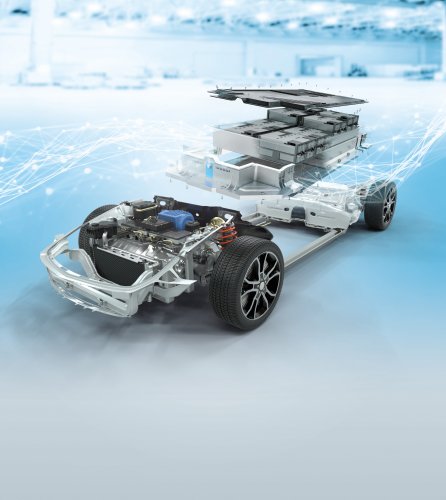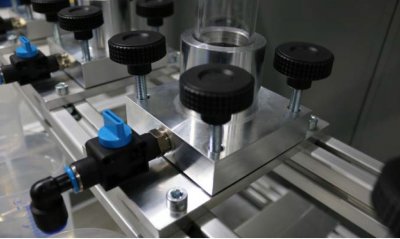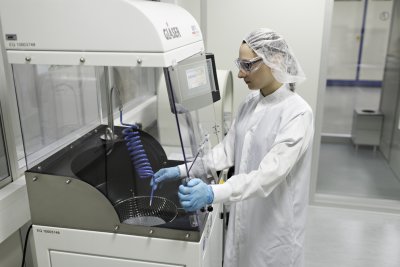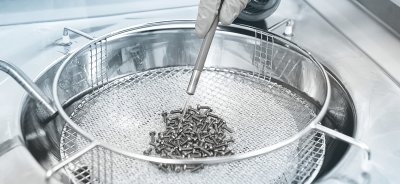Leak-tightness and technical cleanliness go together
Technical cleanliness became a hot topic with the arrival of ABS systems in the 80s, and later, ESP systems. Now companies are increasingly recognising the importance of this sector. But the task of ascertaining, implementing, and guaranteeing technical cleanliness carries with it challenges large and small. When it comes to electromobility, the relationship between technical cleanliness and leak tightness plays a crucial role in the reliable performance of fastenings.

Copy: Annedore Bose-Munde
Clean and tight - this essential technical relationship is the basis for leak-tight fastening solutions such as are required in the electric vehicle sector. Arnold Umformtechnik investigates the fundamentals required to guarantee leak-tightness and cleanliness, specifies applications, and analyses the factors that influence the system.
“Technical cleanliness is one of the basic requirements to achieve the required leak-tightness,” said Leon Münkel. He has been working at Arnold Umformtechnik’s Research and development department since the beginning of April this year. He focuses on leak-tightness. “The tightness requirements that customers are currently demanding means watertight. So, when looking at the “clean and tight” question we need to check how clean the component needs to be to meet those requirements. For example, all the joins on a battery case have to be water-tight,” he explained.
Arnold Umformtechnik has been active in technical cleanliness for many years now and was pretty much the pioneer in this field. Daniel Schmidt knows the subject very well. He has worked at the company since 2010 and in the Cleancon department since 2016. Cleancon - the brand name for the company’s technical cleanliness concept - focuses on the requirements of the automotive industry and of VDA19.1, the specification for testing technical cleanliness. He pointed out: “for many businesses technical cleanliness is often something of a novelty. They often pay little attention to it. But we are noticing that it is becoming increasingly significant for companies.
The aim is to evaluate a product’s leak-tightness
Besides experience and accurate measuring and analysis equipment, we need sound knowledge of the application and also of individual processes to be able to develop perfect water-tight fastening solutions for every application. Nico Künkel is well aware of the questions and requirements that customers have. He has been working at Arnold Umformtechnik as a Fastening Solutions project manager for five years now. He is responsible for assessing customers’ enquiries, the manufacturing feasibility of fastening solutions, cost calculations, capacity estimates, and support for new parts through to initial production. “We need to create an awareness that a certain requirement for leak-tightness also requires a defined degree of cleanliness. And we need to point out the effects on watertightness. According to Künkel, it is also important to examine the media used to create the seal. Will the same cleaning process that has always been used be enough for the mechanical or chemical sealing media planned for the application? Or do we need to introduce special cleaning processes to deal with the individual customer’s solution?
Target group and guidelines for approaching the subject of cleanliness
“Cleanliness means the absence of particles to a certain level,” said Daniel Schmidt. So when looking at the customer’s application the aim is always to create a defined degree of cleanliness. In other words, we have to ensure that the particle load does not exceed a defined level. Over the years Arnold has built up a wealth of experience in this field. “We can tell a customer with great accuracy what is technically feasible and where the limits of feasibility currently lie. The main task is always to clean and analyse the products and maintain that level of cleanliness until it reaches the customer.
Besides cleanliness analysis, another option at Arnold is to investigate residual magnetism. Components can undergo a demagnetisation procedure before they are cleaned. This increases the level of cleanliness and meets residual magnetism requirements. This is often specified on component drawings.
The requirements for technical cleanliness were first set by the automotive industry. Today, general regulations set a standardised framework to achieve technical cleanliness. These include VDA19.1 for testing technical cleanliness, VDA 19.2 for technical cleanliness in assembly; then there is ISO 16.2.3.2, as well as a guide to technical cleanliness for the electronics industry published by the ZVEI [German Association of Electrical and Digital Industries].
A large number of Arnold’s customers are in the automotive industry. Which is why the company focuses on the sector with its Cleancon concept.
Test equipment to determine leak-tightness and cleanliness
Arnold Umformtechnik has a comprehensive range of instrumentation to analyze leak-tightness and technical cleanliness. The company boasts two leak-tightness test benches that use test gas to measure leaks, a mass spectrometer that uses helium as its test medium, and a differential pressure method, using air as its test medium. Added to the above there is another leak test bench using water as its test medium that can additionally produce an IPX7 certificate. This requires a component to be submerged in water at a depth of one meter for 30 minutes and remain functional with no leakage.
For the cleanliness analysis, it is important to determine the specific particle load present. At Arnold contaminating particles are detached and gathered up inside an extraction cabinet. There are several different ways of making the necessary analysis that follows. For example, the part can be analysed under an optical microscope used to determine the length and width of any contaminating particles and can categorize them as metallic bright or non-metallic bright. Laboratory scales can provide information on particle mass. Arnold has recently acquired a scanning electron microscope. This can ascertain the chemical elements that make up a contaminating particle. It can also conclude the source of error. Moreover, the company has a residual magnetism test stand. The contaminating particles we are speaking about here are so small that in most cases they cannot be seen with the naked eye. And it is never possible to see with your eyes whether a component is magnetic,” explained Daniel Schmidt.
Developing perfect solutions for individual customer applications
The “clean and tight” theme plays an important role for many fasteners. Here the focus is on leak-tight applications such as battery cases, final assembly and installation. It is also very important for the electronics industry, for example when conductor tracks are set close to one another. Clean fasteners are absolutely essential when used in any oil-conducting systems as well as for the sensor technology in autonomous vehicles. Complex multi-functional and multi-stage components - such as those produced by Arnold’s Conform Next process - can also be included in these cleanliness analyses.
The aim of the ‘clean and tight’ analyses at Arnold Umformtechnik is to guarantee a reliable evaluation of the leak-tightness of the fasteners within the context of the customer’s application. As well as ascertaining how leak-proof a component is, the analysis should also include long-term effects such as corrosion or environmental influence. From all these analyses it is possible to derive a result as to which fastening solutions will meet what leak-tightness requirements.
“We support our customers throughout the entire development process. We can assess feasibility at an early stage, and if necessary, can suggest an alternative fastening solution,” said Leon Münkel as he explained the methodology. It means that we can develop the perfect solution for each individual customer enquiry.
An overall view of the entire process is important
Just how clean does a fastening need to be reliable? “Cleanliness is established as early as the design process,” said Daniel Schmidt. But a clean screw is not the end of the process. We have to look at the way it is processed, transported, and handled. In other words, an overall view of the entire process is important.
With Cleancon Arnold has developed a multi-layered patented packaging concept to maintain the cleanliness level for its fasteners, covering every step of the way from development, production, and delivery. The company is also currently developing an environmentally friendly packaging solution.
The full package from a single supplier
In principle, the concept aims to improve customers’ applications by localising and preventing leaks. The result for the customer is increased process reliability. Cleanliness levels in products supplied by Arnold can therefore form the basis of cleanliness in any further processing.
“It’s not just that our customers can use our equipment to investigate for leak-tightness and cleanliness. They also get a complete package, starting with development, continuing with the functional samples and services, through to manufacturing and supplying the parts to a clearly defined level of cleanliness,” said Nico Künkel, describing the services offered by the fastenings manufacturer based in Forchtenberg, SW Germany.
One thing of which we can be certain is that technical cleanliness is a quality characteristic that is gaining increasingly in importance.
Picture captions:

Image 2: Motivvorschlag: passendes Bild, z.B. einer der Prüfstände
Arnold Umformtechnik boasts two leak-tightness test stands measuring leaks with test gas, as well as another leak-tightness test stand that uses water as its test medium, and which can produce an IPX7 certificate.

Image 3: Motivvorschlag: passendes Bild zum Extraktionskabinett At Arnold contaminating particles are detached and gathered up inside an extraction cabinet.

Picture 4: Motivvorschlag: passendes Bild vom Rasterelektronenmikroskop Arnold has recently acquired a scanning electron microscope. This can ascertain the chemical elements that make up a contaminating particle. It can also draw conclusions about the source of error.

Image 5: Motivvorschlag: Picture of Daniel Schmidt “For many businesses technical cleanliness is often something of a novelty. They often pay little attention to it. But we are noticing that it is becoming increasingly significant for the company,” said Daniel Schmidt, Technical Cleanliness Department at Arnold Umformtechnik.

Image 6: Motivvorschlag: Picture of Nico Künkel Nico Künkel, Project Manager for Fastening solutions at Arnold Umformtechnik, is well aware of the questions and requirements that customers have. He stressed: “We need to create an awareness that a certain requirement for leak-tightness also requires a defined degree of cleanliness. And we need to point out its effects on watertightness.”

Image 7: Motivvorschlag: Picture of Leon Münkel “We support our customers throughout the entire development process. We can assess feasibility at an early stage, and if necessary, can suggest an alternative fastening solution,” said Leon Münkel, R&D Fastening solutions, as he explained the methodology.
All images: Arnold Umformtechnik
Carl-Arnold-Str. 25
74670 Forchtenberg-Ernsbach
Wanke Magdalini
Phone : +49 7947 821-2833
Fax : NA
Magdalini.Wanke@arnold-fastening.com
